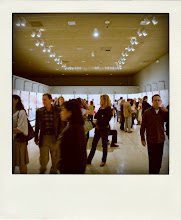A number of my earlier blog posts have given some idea of the never-ending (but nonetheless rewarding) task of research on the permanent collection. Here's another episode in "the life of a painting," showing how stories and misinformation can gradually accrete on the canvas.

The portrait at left is by the Nabi artist Pierre Bonnard (1867-1947) and hangs in one of the small upstairs galleries with the rest of the collection given to the Museum by Ambassdor and Mrs. Maxwell Gluck. Executed in the broad, flat patches of color and thick brushstrokes typical of Bonnard’s work, the painting has always been identified as a portrait of a “Monsieur Monteux.”
At some point in the late 1960s or early 1970s, before the painting came to the Museum, the title evolved. Whereas before it was simply identified as "Monsieur Monteux," suddenly it became a "Portrait of Pierre Monteux."
This is a case of wishful thinking. Someone must have asked, "Who was this Monteux?" ...and then found the most famous Monteux possible: Pierre Monteux (1875-1964), one of the great conductors of the early 20th century. He had been the conductor for Diaghilev's Ballets Russes in Paris in the early 1910s but left Europe at the outbreak of World War I and came to America, where he was later conductor of the Boston Symphony Orchestra and the San Francisco Symphony Orchestra.
Moreover,

the sitter in the portrait bears some resemblance to Pierre Monteux. Here, at right, is a photograph of him published in Life magazine in 1950.
But the problem is this: Bonnard's painting was made much, much earlier... at least 35 years before that photograph, to be precise. If a portrait of Pierre Monteux, Bonnard's canvas would have had to be painted by 1915, when Monteux left France, but the conductor was only then 34 years old, and the sitter in the portrait is a much older man. The Bonnard catalogue raisonne, moreover, dates the painting to ca. 1915, presumably on the basis of style.
So if not Pierre Monteux, who is it? There is another Monteux who seems to fit. Marcel Monteux, the owner of the Chaussures Raoul chain (the first mass-produced shoe chain in France), was an early patron of the so-called Nabi group of artists, which included Bonnard and his associates Edouard Vuillard, Maurice Denis, and Ker-Xavier Roussel. Roussel's decorative paintings for the Monteux house, for example, are today in the Dayton Art Institute. Marcel Monteux also owned works by Degas and other leading artists of the day. If Bonnard painted a portrait of an older Monsieur Monteux in 1915, Marcel Monteux would seem to be our man. Unfortunately, there do not seem to be any other portraits or photographs of Marcel Monteux to compare, so for now (at least), the painting remains simply a "Portrait of Monsieur Monteux," but at least we've got Pierre out of the picture, so to speak.
-John Marciari, Curator of European Art
(with thanks to Agnes Penot-Lejeune for her help with provenance research)










